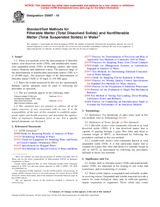Potrebujeme váš súhlas na využitie jednotlivých dát, aby sa vám okrem iného mohli ukazovať informácie týkajúce sa vašich záujmov. Súhlas udelíte kliknutím na tlačidlo „OK“.
ASTM D5907-10
Standard Test Methods for Filterable Matter (Total Dissolved Solids) and Nonfilterable Matter (Total Suspended Solids) in Water
Automaticky preložený názov:
Štandardné testovacie metódy pre filtrovateľný hmoty ( Celkom rozpustených látok ) a Nonfilterable hmoty ( celkových nerozpustených látok ) vo vode
NORMA vydaná dňa 15.5.2010
Informácie o norme:
Označenie normy: ASTM D5907-10
Poznámka: NEPLATNÁ
Dátum vydania normy: 15.5.2010
Kód tovaru: NS-33043
Počet strán: 9
Približná hmotnosť: 27 g (0.06 libier)
Krajina: Americká technická norma
Kategória: Technické normy ASTM
Anotácia textu normy ASTM D5907-10 :
Keywords:
dissolved matter, filterable matter, nonfilterable matter, suspended matter, total dissolved solids, total suspended solids, Dissolved elements (of water), Drinking water, Filters/filter procedures--water testing, Industrial water treatment, Nonfilterable matter, Surface water, Suspended matter, Trace elements--water analysis, ICS Number Code 13.060.60 (Examination of water for physical properties)
Doplňujúce informácie
| Significance and Use | ||||||||||||||||||||||||||||||
|
Solids, both as filterable matter (TDS) and nonfilterable matter (TSS), are important in the treating of raw water and wastewater, and in monitoring of streams. Waste solids impose a suspended and settleable residue in receiving waters. Suspended and soluble materials provide a matrix for some biological slime and, in sufficient quantity, impair respiration of organisms. These solids may create nuisance slime beds and odors while imposing a long-term biological oxidation load over limited receiving water areas. Knowledge of suspended and soluble materials is important in treating raw water supplies. Knowledge of solids loading can aid in determining the type or amount of treatment, or both, necessary to make the water acceptable for use. Such information may also be used to determine acceptability of water after treatment. Too little treatment may not be desirable and excess treatment costs money. Stream monitoring is important for environmental reasons, such as compliance with discharge permits. Stream improvements, water pollution monitoring, mass wasting, algal studies, and sediment loads are but a few of the many reasons streams are monitored. |
||||||||||||||||||||||||||||||
| 1. Scope | ||||||||||||||||||||||||||||||
|
1.1 These test methods cover the determination of filterable matter, total dissolved solids (TDS), and nonfilterable matter, total suspended solids (TSS), in drinking, surface, and saline waters, domestic and industrial wastes. The practical range of the determination of nonfilterable particulate matter (TSS) is 4 to 20 000 mg/L. The practical range of the determination of filterable matter (TDS) is 10 mg/L to 150 000 µg/g. 1.2 Since the results measured by this test are operationally defined, careful attention must be paid to following the procedure as specified. 1.3 The test methods appear in the following order:
1.4 This standard does not purport to address all of the safety concerns, if any, associated with its use. It is the responsibility of the user of this standard to establish appropriate safety and health practices and determine the applicability of regulatory limitations prior to use. For a specific hazard statement, see Section 8. |
||||||||||||||||||||||||||||||
| 2. Referenced Documents | ||||||||||||||||||||||||||||||
|




 Cookies
Cookies
